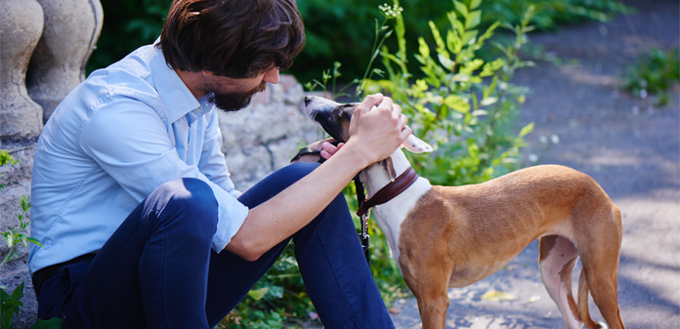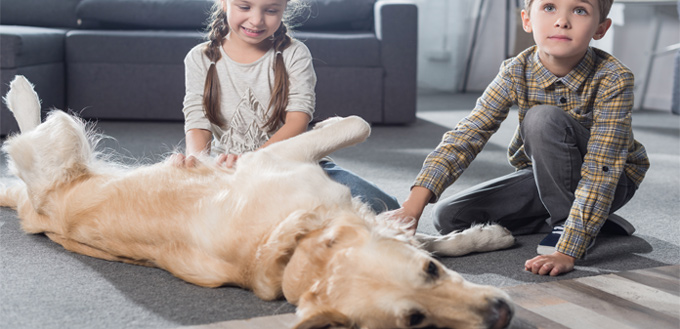Does your dog react to words of praise? Let’s say, you look at your dog and say, “Good job, my boy!” How does your dog react? Is the reaction similar when you pet instead of using words?
Scientific Research
Well, research shows that dogs prefer petting over mere words of praise. Researchers conducted a study in which they observed the behavior of 42 shelter and home dogs, as two people interacted with each of them personally. One person petted the dog without saying anything while the other just stood and showered words of praise without touching the dog.

The researchers noted down the amount of time that the dog wanted to interact with each person. These dogs were again put through the same routine after a few days. The researchers recorded eight three-minutes sessions, where in each session, the dog was either praised or petted.
When the results were analyzed, the researchers found that dogs interacted well with those strangers who petted it. Also, the dogs showed no interest in the person who praised it. In fact, its reaction was similar to having no human interaction at all.
Now, this brings up an interesting question – Why do dogs like to be petted? What goes on in their mind and body when they get the touch of a human?
Let’s find out.
What Happens When you Pet Dogs?
A lot of research has been conducted in this area and all of it conclusively prove that when you touch your dog, its heart rate and blood pressure go down.
- Emotional bonding
Remember, dogs and human beings are alike in many ways, especially in how they bond emotionally. This is probably why dogs have become so close to humans over the last several centuries.
This also means that dogs yearn for human relationships, attention, and petting. Just like how you feel better when you have some kind of physical contact with another human being, dogs also feel better.
Have you ever seen small babies cry when no one is around? As soon as their mother picks them up, they stop crying. This is because they have an emotional bonding with their mother and this bonding is what soothes them.
The same is the case with your dog too. It has a deep emotional bonding with you.
- Security
Dogs get a secure feeling when you touch them. They want to know if you still love them and ready to care for them. The best way to express these feelings is by petting them. Your soft touch and the gentle petting reaffirms many things about your relationship and they feel safe and secure with you.
The chances for a dog to run away from the house or have mental problems is greatly reduced with constant petting, again just like human beings. If you analyze the causes of depression, many scientists are pointing their fingers at increased isolation, growth of conditions like social anxiety, too much time with gadgets, and above everything lack of physical contact with other human beings.
Just like us, dogs go into depression too when they don’t get your touch because they worry too much and feel insecure about their future.
- Attention seeking
All pet owners know that dogs are like human babies, both of them need attention all the time. When you’re distracted or talking to someone else, the dog may want you to pet her. This is plainly attention-seeking behavior, and there’s nothing wrong with it too!
After all, you’re its best companion and the only hope for its future, so it wants to ensure that it is always around you and is not making you angry. It gets comfort in such attention-seeking behavior.
Now that we know the advantages, start petting right away. But before that, know where your dog likes to be petted because touching certain areas can really annoy her!
How to Pet a Dog?
Though each dog is unique, there are some aspects that are common to all of them, and petting is one of them. In fact, petting them the right way is absolutely essential if you want to build a good rapport with your dog.
Let’s now see some broad likes and dislikes that most dogs have when it comes to petting.
- Dog should take the lead
The ground rule of petting – never touch a dog that doesn’t want to be petted. Always, the dog will give cues when it wants to be petted. It will initiate and will come near you. When the dog doesn’t initiate contact, never pet it.
It is important to teach your children to follow this rule because they are the ones who will try to touch a dog that is lying down, sitting in a corner or just trying to get away. Children, in their enthusiasm, do not understand this by themselves and this is why it is important to teach them.
As an adult, if you want to pet, but the dog isn’t showing any interest, you can either wait for it to initiate contact or invite him to make the first contact. For example, you can squat down at his level because some dogs may feel scared to come near you. Another option is to have a treat in your hands, as this could motivate the dog to come near you.
Either way, the first step should come from your dog.
You May Also Like: Dog Treats
- Avoid hovering
Avoid hovering over the dog when you’re trying to establish contact. This movement is often seen as a threat by the dog, and they tend to get intimidated. Depending on the dog’s personality, the dog could either go into a shell, make an aggressive move or run away from you. Instead, turn your body slightly to the side and look at the dog. Avoid eye contact during your first meeting, as this gesture is also interpreted as a threat by the dog.
Another option is to look away, as if you’re pretending to do something else or go away. This would help to bring the dog near you if it wants to make contact.
- Identify your dog’s needs
The dog will let you know when it wants to get petted. One common body language is the dog’s ears. It will be slightly held back as it comes towards you. The tail will also be slightly lifted at a medium height and will wag it hard when it sees you. Also, if his body is relaxed and he makes a brief eye contact with you, this means he is ready for interaction with you.
When a dog comes to sniff at you, it is just finding out who you are and this is not an invite for petting. If the dog is jumpy, it means, he is not sure about you. When you see that gesture, stay away from petting him.
- Right movements
Dogs like to feel repetitive movements while petting. So, do a slow petting with a gentle massage or light scratching and this will greatly calm down your dog. Also, move your hands and fingers in the same direction of the fur as this is therapeutic for your dog.

Where to Pet a Dog?
How should you pet your dog to make it feel comfortable, secure and happy? Most dogs like to be petted on their chest, shoulders and the base of their neck. While petting, it is best you reach these areas through the sides instead of from its head.
Some dogs have specific places where they like to be petted and they will indicate it to you in one form or another. Such areas could possibly be at the base of their tail, back of their neck or the chin area – just depends on each dog’s preferences. If it rolls over its back, it is an invitation to pet its belly!
However, there are some areas that are a clear no when it comes to petting. The part that all dogs hate is their head. Maybe it affects their senses or they feel sensitive or whatever else reason, dogs just hate it when you touch their heads. Likewise, most dogs do not like to be petted on their paws, legs or tail.
The tail, especially is a sensitive area that you should avoid. If you have children, instruct them to avoid catching a dog by its tail, as this could make the dog aggressive.
Also, never slap a dog when you’re excited as this could frighten it. Dogs hate hugs too because it threatens them. They will not be able to run away and it hinders their movements.
In short, petting your dog is calming not just for your dog, but for you too. It creates a deep emotional bonding for both of you, and the dog feels more secure with you. Also, the physical touch could go a long way in keeping your dog happy and healthy!
That said, wait for your dog to initiate contact and pet only in those places that your dog likes.
Sources:
- Jacqueline Howard, Dogs Prefer Petting Way More Than You Thought, Huffington Post
- Mikkel Becker, How to Pet a Dog, Vet Street
- Dr. Sheila D’Arpino, Do You Like to Be Petted by People You Don’t Know?, Center for Shelter Dogs







